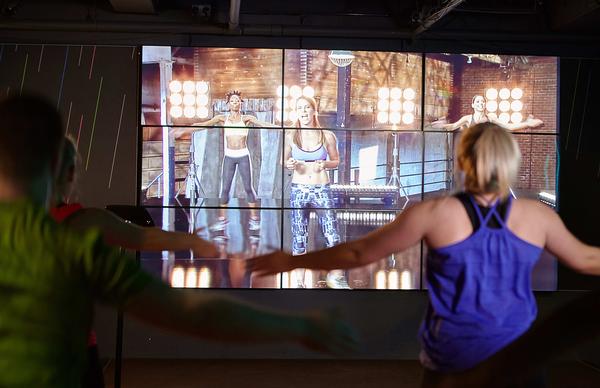features
Interview: Paul Bowman
To stay relevant and at the heart of the fitness experience, gyms and studios must rethink the customer journey, creating packages that match the online fitness behaviours that have been forged in times of crisis, says the CEO of Wexer. He speaks to Kate Cracknell

Has COVID-19 changed the way you perceive the fitness future?
Put bluntly, if you don’t have a hybrid digital/physical model, you won’t survive. I’m more certain than ever of this. Think about how disruptive low-cost was for those who didn’t respond quickly enough. Digital will be equally disruptive.
It’s no longer a question of ‘do we go digital?’ The only question is: do you merge digital into physical, or physical into digital? Which is most likely to succeed? I genuinely believe it will be the latter. The hybrid model is the way things have to be moving forward.
What was the standout change for you during the lockdown?
My biggest learning throughout this crisis relates to home-grown talent: new fitness rockstars have been born.
With the entire sector forced to pivot to an online model to provide workout content to those stuck at home, instructors have come to the fore. They’ve produced some excellent content and reminded us how good they are.
As we continue towards a hybrid future, we need to recognise the power these instructors and trainers hold. They’re now the content creators. They can engage large audiences and are hugely valuable. We need new career paths that maximise this, empowering them to take more ownership of content-related projects that enhance and build operators’ brands.
I’m not alone in this opinion. I recently heard an interview with Gold’s Gym CEO, Adam Zeitsiff, in which he stressed the importance of using your own talent to drive in-club and digital customer journeys.
Zeitsiff was clear the home fitness experience must be delivered on your own platform, not a third-party channel – like Instagram or YouTube – which you can’t monetise or use to generate any brand loyalty.
This is the biggest mistake operators have made in the rush to get online. Third parties offered quick, easy solutions, but clubs have effectively given away their contacts, their opportunity to gather data and insights and their ownership of the customer relationship to these B2C platforms. They now have to wrest it back.
What evidence do you have to support the case for a hybrid future?
We were seeing strong growth in on-demand fitness before COVID-19. Spend on traditional gyms and classes grew around 5 per cent in 2019; on-demand fitness spend jumped nearly 59 per cent in the same year.
This growth was from a small base: online accounted for only 6 per cent of the market, set against the 72 per cent share enjoyed by traditional health clubs. However, the trend is there. Not only that, but on-demand retention figures beat most traditional operators: about half of online fitness customers are retained for nine months or more.
Our growth trajectory echoes these findings. In 2019, we saw a 66 per cent growth in the number of Wexer Virtual classes being run around the world – up to 10 million from 6 million in 2018 – and a 59 per cent growth in mobile revenues.
So, digital fitness was already growing fast. Then COVID-19 happened and things accelerated exponentially: we had clients whose online user base grew 10-fold almost overnight. An insightful new report from Mindbody, published in May, made similar findings. Between March and May 2020, during COVID lockdown, 71.5 per cent of its respondents had taken part in pre-recorded virtual classes, and 81 per cent in live streamed classes – up from 17 per cent and 7 per cent respectively in 2019.
How about the response from consumers?
During lockdown, online was one of people’s only options, but they certainly maximised these opportunities to stay active. We did some research with three of our clients, comparing the usual monthly turnstile swipes with online classes attended during lockdown, and found the correlation to be 96 per cent – that is, almost exactly the same number of online workouts being done as would normally be done in-club. Neither was this skewed by online ‘super users’: the operators reported that people were to a large extent maintaining their usual routines.
Many respondents in the Mindbody survey were exercising more often: the proportion of people exercising on a daily basis jumped from 5 per cent before lockdown to 22 per cent throughout the period March – May 2020, driven both by having more time on their hands and by the convenience of online platforms.
It seems this shift towards online is not simply a temporary measure for some people: 43 per cent said that, post-lockdown, they would continue to do at-home virtual classes, as well as going back to the gym. Of those, 60 per cent expected to add two or three live streamed workouts a week.
As we emerge from lockdown, consumers have a greater understanding of the value of fitness and the options available to them beyond the gym. We’re projecting the delivery of 25 million workouts through our ecosystem in 2020, for example.
Is hybrid the right model for every operator?
I believe it is. Before COVID, the boutique sector was the only one I was in two minds about: the brands were strong enough to be able to extend into the online space, but equally the in-person experience was hugely important. Now – at least for the foreseeable future, with in-person capacity limited due to social distancing – even just from a commercial standpoint, I believe every club and studio has to adopt a hybrid model.
However, it does require flexibility and a new approach to membership structures. It also requires operators to be nimble, because priorities are shifting fast. Clubs must get used to testing small and fast among members, former members and prospects – quickly learning as they go.
What might new membership structures look like?
Online content can’t be free forever. It has to be monetised. However, if operators just look at their current membership packages and try to crowbar digital in as an add-on, they’ll limit their creativity. They’ll also fall into the trap of overtly attributing a price to an online offering that was previously free, and that’s a difficult conversation to have.
What’s needed is a fresh approach that combines digital support and physical attendance into new membership tiers: the more a member pays, the more personalised the offering becomes online and the more human elements there are to it.
Clubs could even test dynamic pricing, whereby members pay less per experience the more experiences they book. That could be a way to drive revenues – because the end goal for most will still be high-yielding memberships. However, there does need to be far more flexibility and choice in membership structures than has been the case to date.
It’s hard when operators have previous revenues in mind. The instinct is to look at how the sustainability of the physical offering might be affected, if a lot of members opt for a digitally-skewed membership that commands a lower price tag.
However, it’s important to recognise that digital opens you up to a bigger audience. There may be less revenue per head, but there are many more heads to go after. In fact, during lockdown, 40 per cent of all spend on live streamed and pre-recorded workouts went to businesses those individuals had never physically visited.
A hybrid model offers potential to grow your market, so it’s time to be bold and rethink pricing and membership tiers.
Any other thoughts for operators looking to adopt a hybrid model?
Map out your entire online customer journey and your entire in-club journey and review them with a critical eye. Where do they overlap? What can you add to them? What are their respective USPs?
We know exercising 2+ times a week drives loyalty to the platform or brand facilitating it, so start with the objective of getting people to work out three times a week. Where might that mean a digital workout and where it might be in-person?
And how do you combine all of this into new packages that put the customer first, making sure you’re offering something for everyone, wherever and whenever they want it?
Pre-COVID, digital was seen as an online extension of the in-club experience, but lockdown has flipped this on its head. Clubs should now start with the home fitness journey, working out how to gain a competitive advantage here, before working out how to dovetail physical visits into this.
What might the digital element of a hybrid model look like?
We’re likely to see three content prongs: professionally produced live streaming of operators’ top stars; amateur live streaming by local instructors; and a large on-demand library.
You need all three prongs to engage all audiences. Lockdown has shown the power of gyms’ own talent, and we know live streaming delivers high levels of engagement. But online requires strength in depth to be sustainable, with multiple class options available in every class type and every length, because people only do the same online class twice before they look for something new. This compared to doing the same in-club virtual class eight times. In-club it’s about the social. Online it’s all about variety.
What innovations are you working on?
With the above three prongs in mind we’ve evolved our Web Player product – an online fitness platform we can white label for clubs that can be accessed on any internet-enabled device. It’s password-protected, so it can be monetised.
The Web Player has always provided access to hundreds of on-demand, music licence-free classes, curated from our global content providers. The classes mirror those available on Wexer Virtual, meaning people can enjoy the same on-demand classes at home as in-club. There’s something for everyone, and variety within each workout type – a useful resource as clubs re-open and instructors have less time to spend on content creation.
However, going back to my main learning from this crisis, clubs will want to use their own instructors to create their own content, so last month, we launched Web Player Connect – a new solution that’s integrated into the Web Player and that gives operators their own TV channel, at no extra cost.
Clubs can use Web Player Connect to stream their own content on their own branded platform, meaning all three prongs of digital content sit together in the same monetisable, branded space.
For quality control, all Web Player Connect content goes into a production folder, allowing HQ to review before sending it live.
Will the in-club experience also change?
In clubs that have already re-opened, we’re seeing higher demand for virtual classes. This is currently the only way to take part in group exercise in many clubs, and with social distancing meaning reduced capacity, classes are regularly full.
We expect live streaming to come into its own, both to members’ devices out of the club and to overflow zones in-club.
But we need to think more creatively, including making physical visits more of a VIP experience.
In April, we did member research via clients in Australia, Germany and the US, and members told us they expected their clubs to reward them for being loyal online members. As an example, while social distancing remains in force, they felt only those who regularly did online classes with a specific instructor should be given the chance to book into a (limited capacity) live class with them.
This need for VIP in-person experiences will continue in the long-term too, even once there’s a vaccine or the pandemic is under control. Training at home is just so convenient; home is where the bread and butter of fitness will now happen. People will still be willing to pay for programming, expertise and support, but the baseline of this will be delivered online via convenient, high-quality, personalised fitness content.
In-person will have to be more special, with experiential events that take place both in clubs and at other great locations via partnerships. We’ll see a rationalisation of club portfolios and a growth in VIP pop-up experiences.
What re-opening challenges do you foresee?
Whatever the re-opening criteria agreed by governments around the world, we know we can do it: our sector is good at operations.
Our biggest challenge isn’t an internal one. It’s that some consumers don’t trust each other to do the right thing: to stay a safe distance away, to clean equipment after every use, not to cough on each other.
Until there’s a vaccine, the question is likely to remain in people’s minds: do I really want to exercise at the gym? People want to be active, but they don’t want to be at risk. Particularly in those markets heavily impacted by COVID, it will take time for attendance numbers to return to normal.
And that’s why I believe operators need to look first at their digital home fitness journey, then dovetail a VIP in-person experience into this. It’s now more important to have a competitive advantage in your home fitness offering than in your club-based offering.
What excites you most about the move to digital?
In recent years, fitness has been all about consolidation – low-cost and premium operators squeezing the mid-market to the point of being price-driven.
All of a sudden, we have a real opportunity to add bucket loads of value. As an industry, we’re being forced to work out a journey that engages more people in fitness – and as a result, this is the time when we can shoot up to 20 per cent population penetration, and beyond.
Clubs need to get better at analysing the user data that online platforms gather. We’ve talked about personalisation for years. Digital fitness is the way to speed it up – it’s both the tool to gather the data, and the channel through which to deliver personalisation. That’s hugely exciting.
If we can do all this well, and get people hooked on our content, there will be a far larger base of people interested in fitness when we’re finally back to being able to operate clubs normally. These are the members of the future. That is, unless providers such as Instagram grab them first. And that’s why it’s important for operators to own their online experience.
The company is a digital fitness provider whose ‘ecosystem’ of products is designed to enable operators to own members’ in- and out-of-club fitness experiences through the provision of a hybrid offering.
Wexer Virtual is an on-site solution, designed for big screens in group exercise studios. It offers 1,500 virtual group classes, curated from 60 content partners, all of which can be scheduled or made available on-demand.
Wexer’s mobile portfolio includes three products: a white label app; an SDK (software development kit) solution, which allows content from the Wexer App to be integrated into operators’ own apps; and the Wexer Web Player, a white label, password-protected portal that can be accessed through any internet-enabled device.
This allows operators to upload their own live streamed and on-demand content, featuring their own instructors, as well as providing an on-demand library of 600 virtual classes from Wexer’s global content partners – the likes of Zumba, Cyberobics, Intelligent Cycling, MegaMace and Boxx, among many others.
Complementing these core products is a series of partnership products, including heart rate training system Wexer Beat – created with Motosumo – and Body Bike Switch.








































































